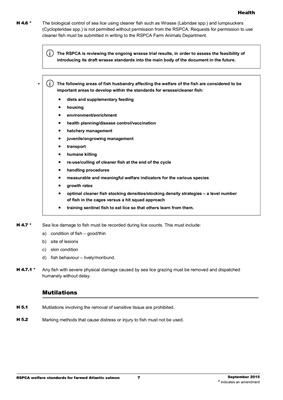
Health
RSPCA welfare standards for farmed Atlantic salmon 7 September 2015
* indicates an amendment
H 4.6 * The biological control of sea lice using cleaner fish such as Wrasse (Labridae spp.) and lumpsuckers
(Cyclopteridae spp.) is not permitted without permission from the RSPCA. Requests for permission to use
cleaner fish must be submitted in writing to the RSPCA Farm Animals Department.
The RSPCA is reviewing the ongoing wrasse trial results, in order to assess the feasibility of
introducing its draft wrasse standards into the main body of the document in the future.
*
The following areas of fish husbandry affecting the welfare of the fish are considered to be
important areas to develop within the standards for wrasse/cleaner fish:
diets and supplementary feeding
housing
environment/enrichment
health planning/disease control/vaccination
hatchery management
juvenile/ongrowing management
transport
humane killing
re-use/culling of cleaner fish at the end of the cycle
handling procedures
measurable and meaningful welfare indicators for the various species
growth rates
optimal cleaner fish stocking densities/stocking density strategies - a level number
of fish in the cages versus a hit squad approach
training sentinel fish to eat lice so that others learn from them.
H 4.7 * Sea lice damage to fish must be recorded during lice counts. This must include:
a) condition of fish - good/thin
b) site of lesions
c) skin condition
d) fish behaviour - lively/moribund.
H 4.7.1 * Any fish with severe physical damage caused by sea lice grazing must be removed and dispatched
humanely without delay.
Mutilations
H 5.1 Mutilations involving the removal of sensitive tissue are prohibited.
H 5.2 Marking methods that cause distress or injury to fish must not be used.
i
i